Alternatives to grass: 10 easy no-mow options for your garden
Smarten up your plot with these stylish alternatives to grass, guaranteed to save you time and hassle


Looking for some alternatives to grass for your lawn? Then grab a coffee, get comfy and read on. We’ve chatted to leading garden industry experts to find out their favorite ideas and to discover the latest products set to transform your plot.
But why replace the lawn? After all, isn’t it meant to be a garden’s crowning glory? Well yes, but there's a chance that your patch of green is anything but. Full of moss, weeds and constantly demanding attention, many grassy areas simply lie neglected – a mud bath in winter and scalped bare and rock hard in summer. The reality is that lush and healthy lawns require plenty of love and regular care and not all of us have the time.
Often covering a large area, opting for something different for your lawn ideas can be an exciting opportunity to completely transform your outside space. Maybe you need a durable surface where the children can play, a dig-free zone for the dog or an all-weather surface for entertaining. Or perhaps the size or position of your garden means that any attempt at growing grass ends up a costly disaster, in which case a sun-loving gravel garden or tapestry of shade favoring beauties could provide a more attractive answer.
Don’t worry that birds and wildlife will object either as many of these alternatives to grass will increase the food and habitat on offer, providing plenty of safe hiding spots too. So go on, take the plunge and replace that tired lawn.
The best alternatives to grass
1. Grow a wildflower meadow
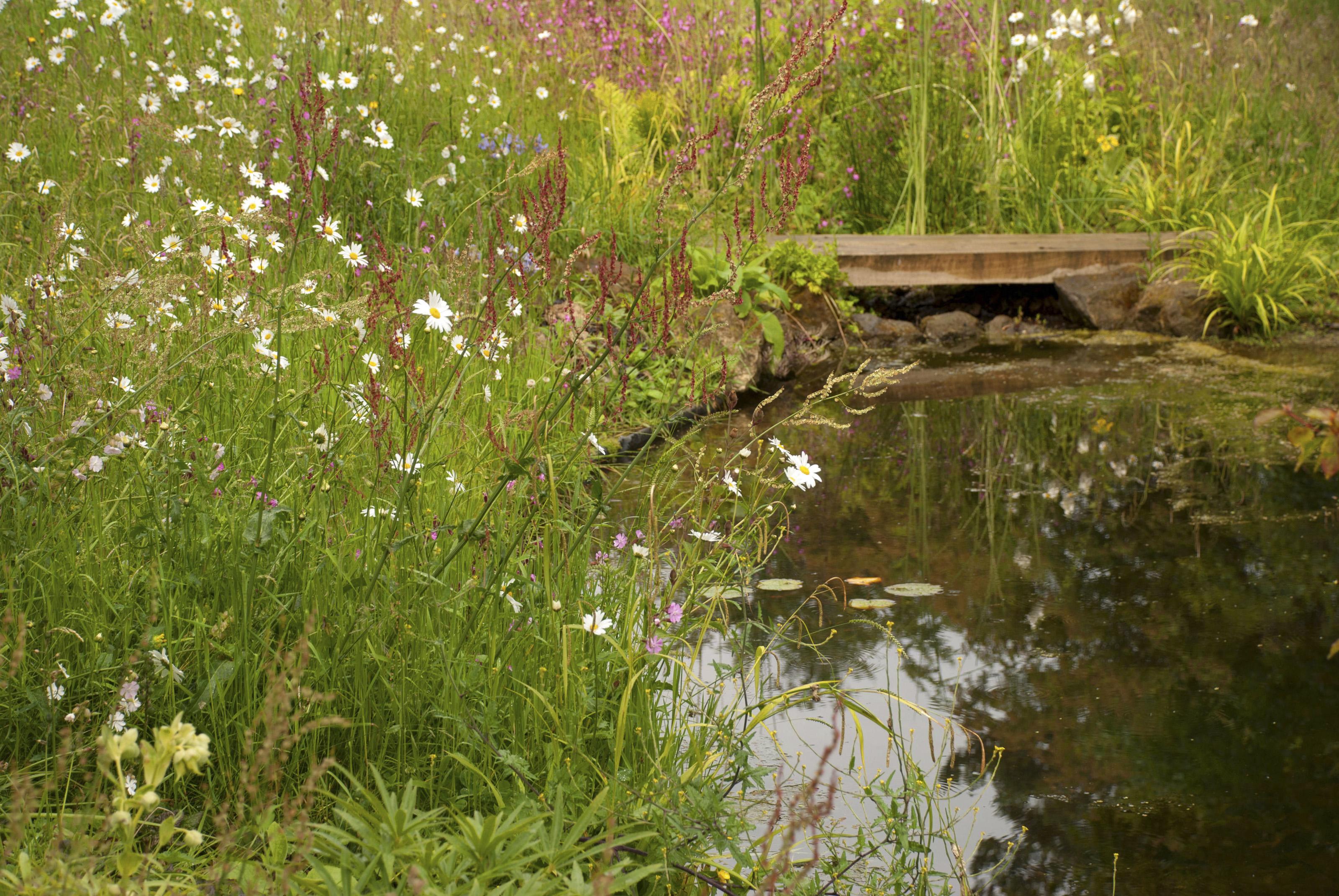
Turf mixes, like this one from Wildflower Turf, are an easy way to create a wildflower area in your garden
Fancy a wild, grassy area that bursts into color every summer? Then discover how to plant a wildflower meadow the easy way, with a mat of established young plants that are ready to root and thrive.
Available from specialist growers such as Turf Online, carefully selected varieties are sown and nurtured to create a dense turf with a strong, developed root system. These are then supplied cut and rolled to customers for a speedy installation.
Varying flower and grass combinations are on offer so you can choose from native and heritage blends featuring favorites such as Cornflowers, Ox-Eye Daisies and buttercups; cottage garden, shade loving and pollinator mixes.
2. Consider ground cover plants
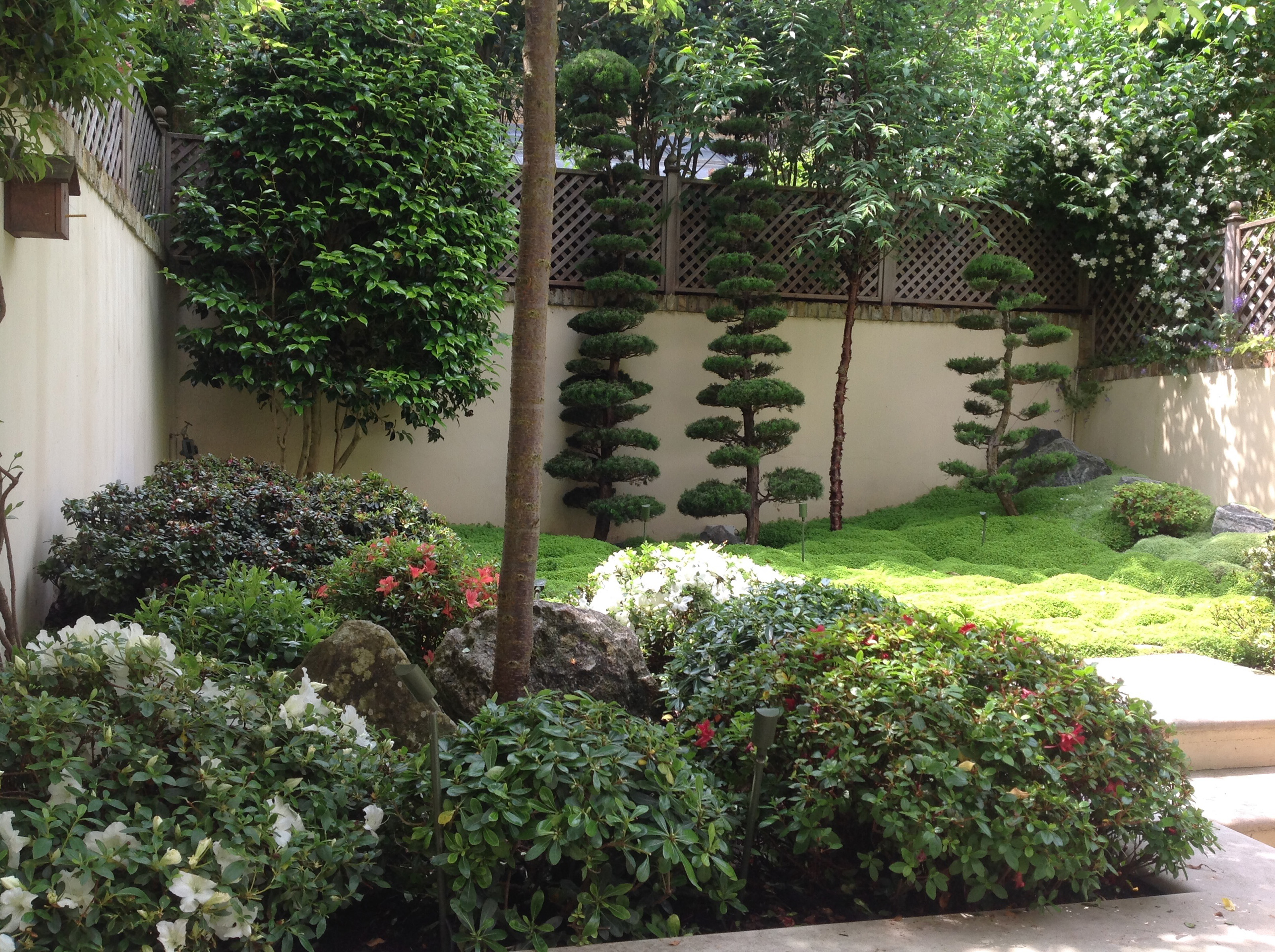
This Japanese-style garden by Maitanne Hunt Gardens uses the moss-like Soleirolia soleirolii as a lawn alternative
Love the lush carpet grass creates, but not the upkeep? Don’t worry, there are plenty of other plants that are up to the job when it comes to alternatives to grass. Mat forming plants such as Rupturewort (Herniaria glabra) and Bugle (Ajuga Reptans) are quick to establish and will form a tight mass of leaves in next to no time.
Corsican Thyme (Mentha requienii) releases a fresh, zesty fragrance when trodden on while Creeping Thyme (Thymus serpyllum) has clouds of tiny purple and white blooms during summer and is a magnet for pollinators.
Although many don’t cope with the wear and tear of constant footfall, these ground hugging beauties will instantly spruce up an open area with color, texture and interest.
The team at Maitanne Hunt Gardens share their knowledge of a recent project. 'We used Mind-your-own-business (Soleirolia soleirolii) as an alternative to moss used in Japanese gardens, taking advantage of its naturally mounding, creeping habit to create the impression of the Japanese hills. Vigorous and low growing, this largely evergreen little gem rapidly creeps over the soil surface, filling gaps between paving or bricks and cloaking imperfections, creating a seamless sea of lush tiny bright green leaves.'
You'll find more of the best ground cover plants in our guide.
3. Lay pollinator-friendly sedum
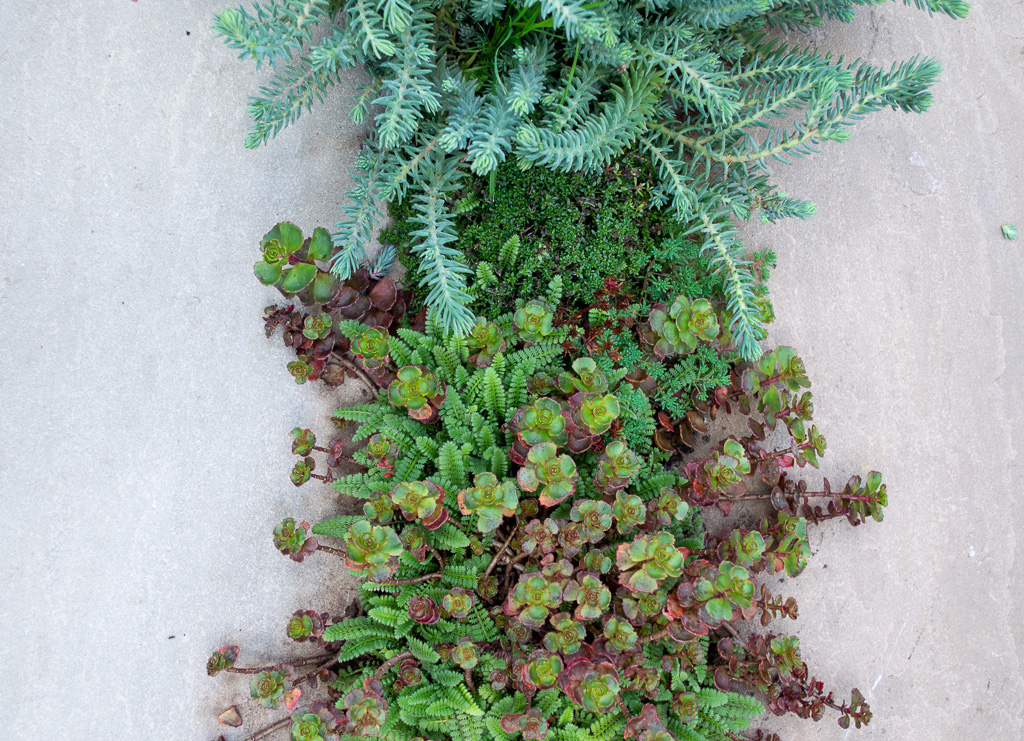
Drought tolerant sedums, thyme and other low growing plants can make a great alternative to a lawn. Design by Alexa Ryan-Mills Garden Design
Swap a sun-scorched, free draining lawn for a mass of sedum, and you’ll soon have an everchanging carpet that’s alive with pollinators. These tough drought-tolerant and frost hardy plants hold their waxy leaves all year round and produce tiny nectar-rich blooms throughout the warmer months.
No need to mow or trim back (you can pack your best lawn mower away for now then), these tight knitting plants actually grow so close they help cut down on weeding too, making them a perfect, no fuss choice for big or small garden ideas.
Design your own covering by planting plugs of stonecrop and meadow Saxifrage close together or opt for a pre-sown matting that has been grown on for twelve months prior to purchase. Keep well-watered until the roots are established.
4. Nurture a Chamomile lawn

Imagine relaxing on a springy, green patch of chamomile inhaling in the sweet, fruity fragrance. A blissful experience much loved by the Elizabethans, it can still delight and revitalise garden lovers today.
The soft feathery leaves hug the ground and send out shoots in summer, creating a beautiful and closely woven covering, making it one of our favorite alternatives to grass. Not to be confused with flowering Roman chamomile, the best variety for a lawn is low growing Chamomile ‘Treneague’.
Ideal for areas that are used occasionally, these plants prefer a sunny position in a light, moist soil and take up to a year to get growing. Once established the leaves do compress when walked or sat upon but don’t worry, they’ll soon spring back up. This also encourages new roots to form.
5. Give moss a go
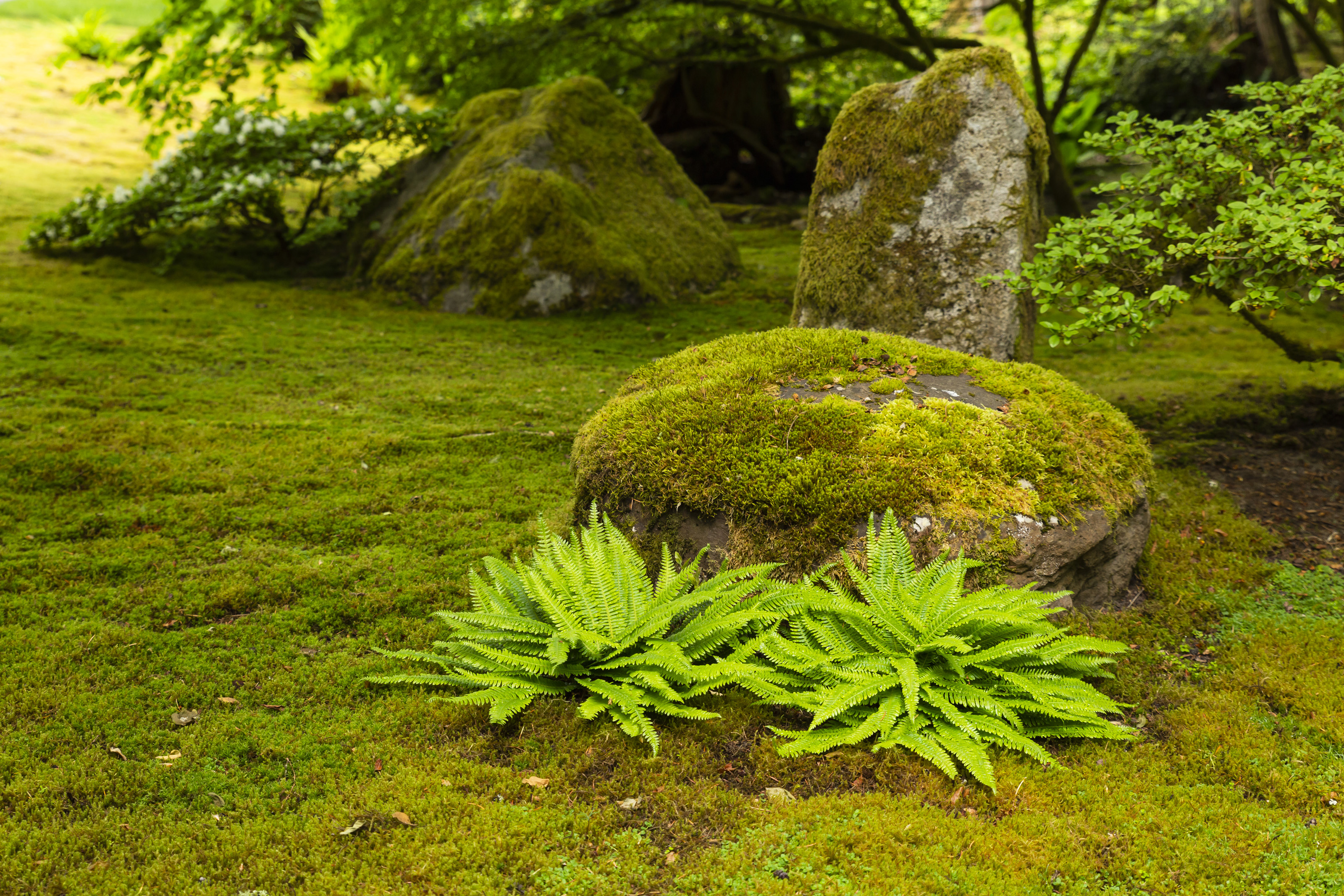
The oldest plant on land, dating back 450 million years, moss is largely self-sufficient. With no root structure and happy to rely on rain for nutrients, it is a magical plant that will cover practically any surface, given time. Ideal for combining with our small Japanese garden ideas, it is revered for its velvety texture, verdant colour and soft undulating mounds.
It makes a brilliant ground covering for small areas as the plant simply squashes flat underfoot, before springing back but it does dislike being scuffed and scraped, so not exactly football or dog friendly.
Largely shade loving, the easiest way to establish a moss carpet is to pin down sheets of live moss, available from online retailers such as All About Moss, keep it well watered and wait. It will take time to establish and for gaps to cover but the result is enchanting.
There's more inspiration for the parts of your garden that don't get much sun in our shade garden ideas.
6. Go casual with gravel

Ditch a tired lawn and replace with gravel for a smart, but laid-back look. Great for suppressing weeds, retaining moisture and encouraging plants to self-seed and spread it’s perfect for easy, low maintenance garden ideas.
Use it to cover areas of any size and aim for a depth of around 5cm laid on top of landscaping fabric. 'A gravel area will need a retaining edge in order to define it and prevent the stones escaping into other areas,' explains Jo Fenton, Partner at Fenton Roberts Garden Design. 'In this garden we used granite setts but we also like flexible metal edging which is versatile and very easy to install.'
Go for a stone size of 20mm to deter cats from digging and think carefully about the best color for your space. Warm toned aggregates such as Cotswold or golden gravel create a sunny, welcoming vibe while limestone and white marble work well for a sharp, contemporary look. For a lush, tropical feel highlight glossy leaved shrubs and ferns with dark grey granite chippings.
Convinced gravel is one of the right alternatives to grass for you? Find suitable ways to keep it in place with our lawn edging ideas.
7. Try bark chippings
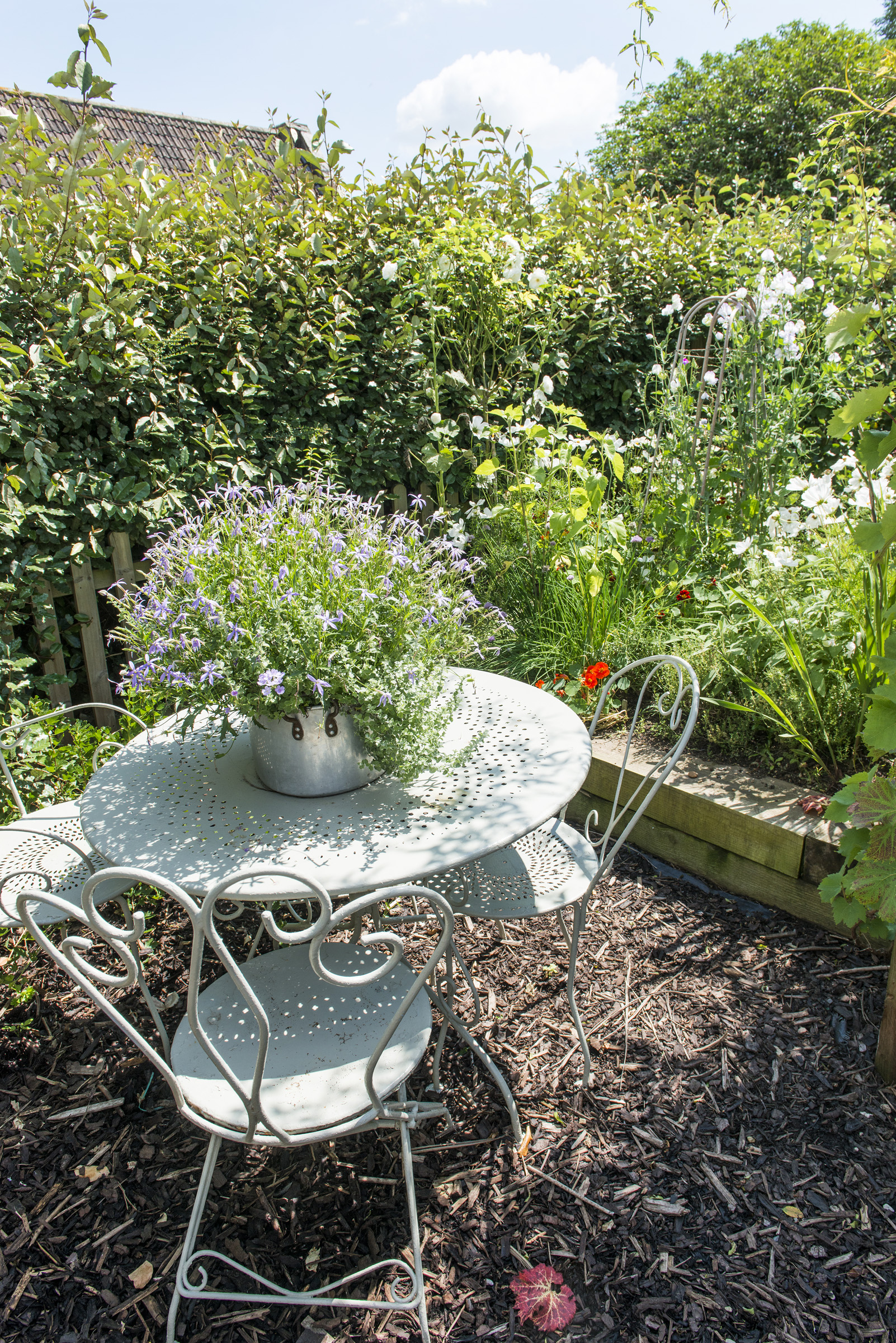
Not just for mulching borders or for adding to play areas to suit family garden ideas, bark chippings are attractive alternatives to grass. Great for smaller areas they are practical and relatively soft underfoot and will accentuate surrounding plants beautifully, requiring little attention.
Go for a layer of chips around 5-10cm deep laid on top of landscape fabric. Use timber sleepers, Corten steel edging or log roll to retain the bark and define areas such as borders or ponds. Alternatively continue spreading chippings under trees and shrubs to the very edges of your plot for a natural and space-enhancing finish.
Bark chippings come in a range of different shades so you can tailor the look, but be sure to go for a FSC approved product to be sure it comes from a sustainable source, especially if you're keen to create an eco friendly garden. Top up every two or three years and avoid using freshly chipped bark around garden plants and trees too, as they can remove essential nitrogen from the soil.
8. Install faux grass

Ok, this is an idea you’ll either love or hate, but artificial grass is a practical option when it comes to alternatives to grass. Available in various shades, fibre mixes and densities, you can opt for everything from pristine bowling green perfection to ‘just mown’ grass complete with realistic thatch to carefully manicured stripes.
One to consider if you're thinking about how to design a child friendly garden, it's pretty simple to install. These products are designed to suppress weeds while letting rain permeate through. A leaf blower or quick sweep will clear up any fallen leaves or debris leaving the surface looking good all year round with minimal fuss.
Perfect for children and pets, you can also relax knowing that grass cuttings and mud won’t be traipsed back into the house. The downside is that this option does little for the environment both in its production and by reducing pollinator and wildlife friendly habitats.
9. Style it up with slate chippings
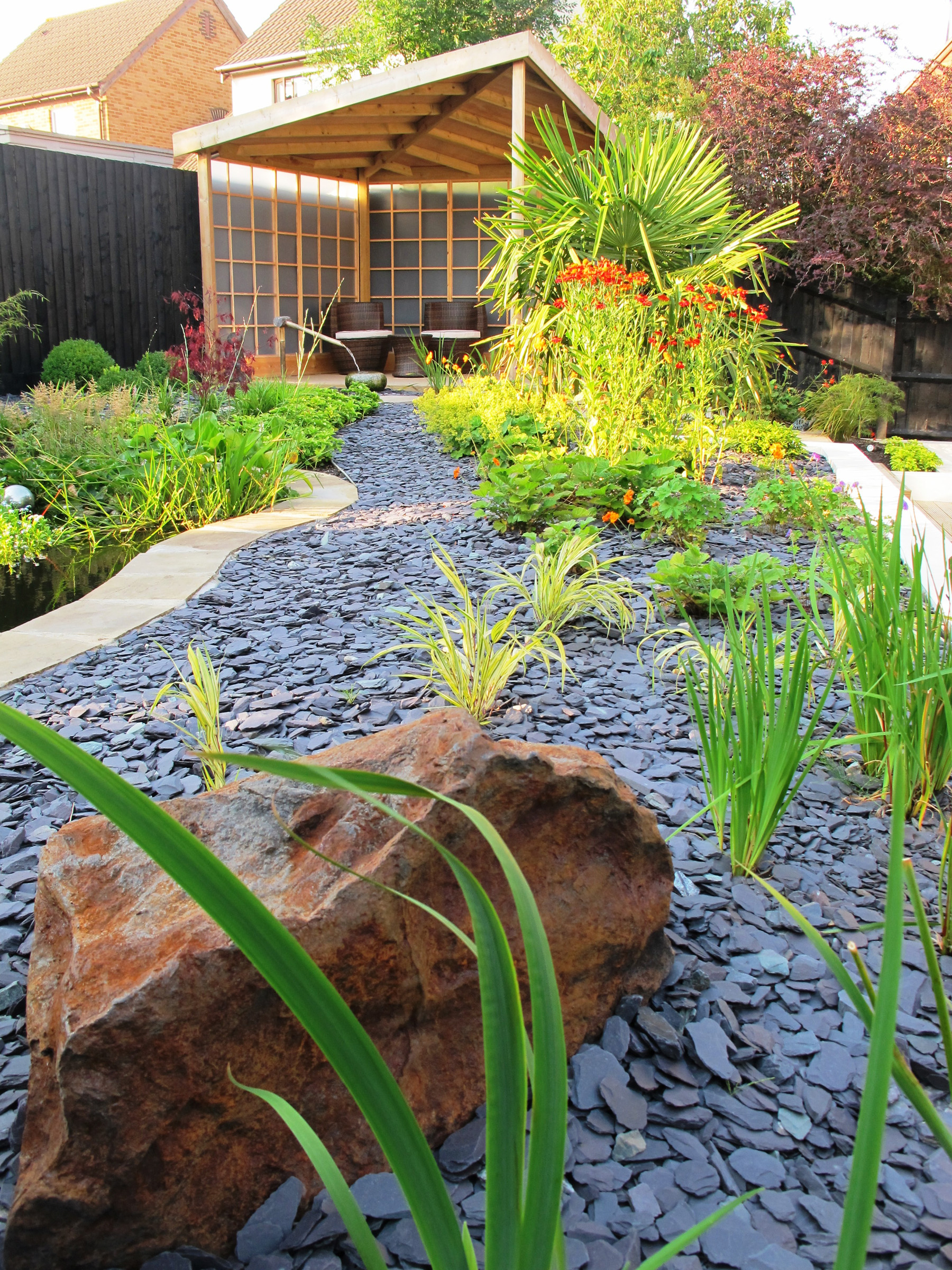
Garden design by Katherine Roper
Heavier and less cat-friendly than gravel, slate chippings are a perfect lawn substitute. Suited to areas of all shapes and sizes they add texture and interest, are easy to lay and come in a selection of different shades.
Blue slate tends to be the most popular but plum, green and graphite are also available. The size of the chippings will not only alter the look and mood created but the spread of the covering.
Smaller 20mm stones do have the ability to ‘walk’ onto nearby beds and paths, so best to opt for larger, heavier 40mm chips to avoid this. The cool tones and flat shape of this aggregate complement modern garden ideas as well as Japanese-inspired gardens, as garden designer Katherine Roper explains. 'We used Delabole blue slate chippings in this client’s gardens as they wanted a zen-like feel and didn’t want a lawn. Aesthetically the blue works well and it’s darker, so the plants stand out. We painted the fences black for the same reason.'
10. Lay easy-care decking
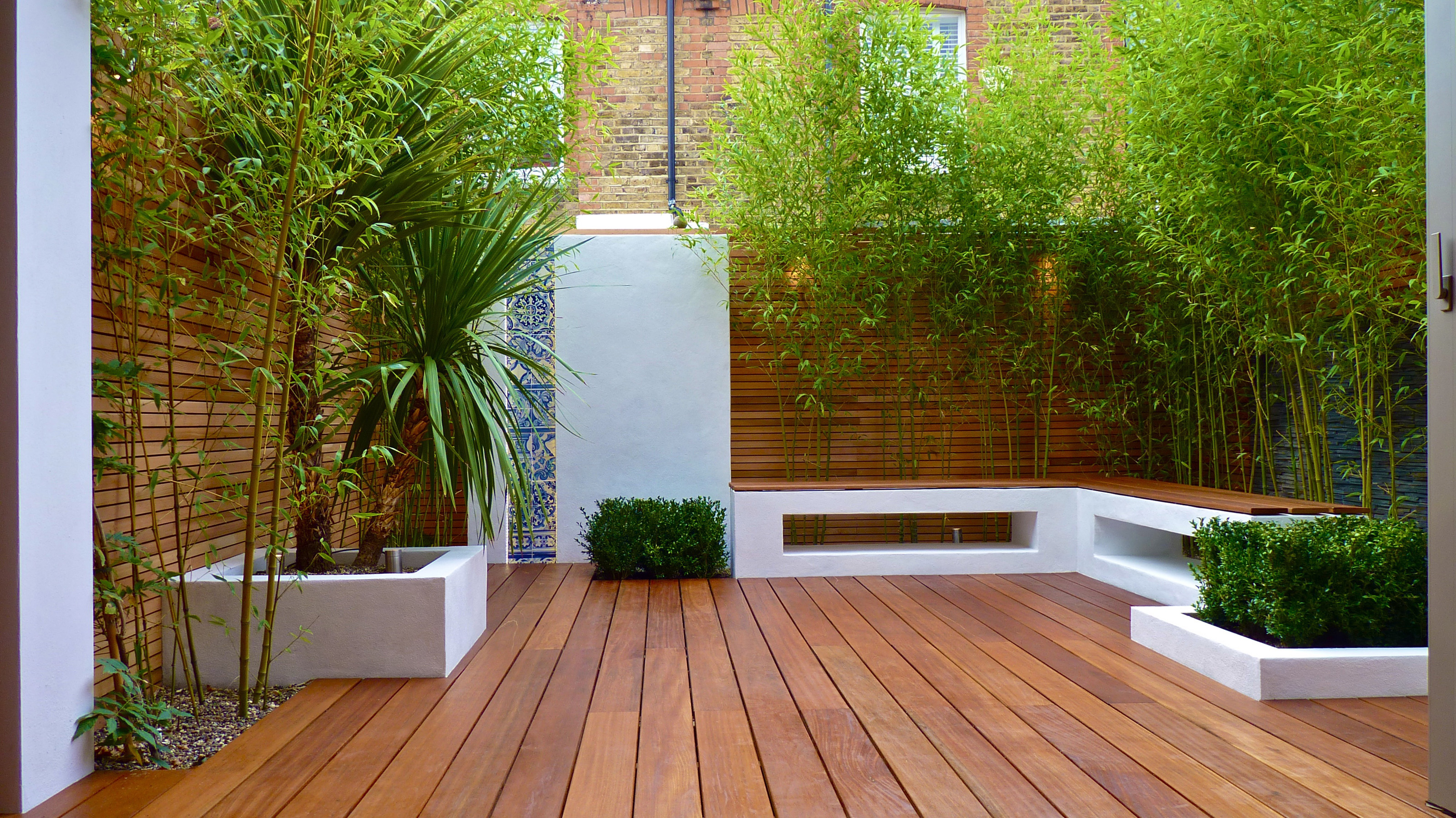
Garden design by Cityscapers
Want to make your outdoor space usable 24/7? Then adding one of our favorite decking ideas is a must. A level, mud-free, uninterrupted surface is supremely practical and will encourage you to move outside and use your backyard with minimal hassle.
The best composite decking has superseded standard grooved deckboards, requiring less upkeep and proving durable in all-weathers, but hardwood designs remain at the top of the most-desirable list.
Nigel Gomme, landscape designer at Cityscapers tells us more about this recent project: 'The deck features smooth planed Yellow Balau hardwood decking boards which, contrary to the name, are warm medium brown in colour. The wood is FSC certified, an important environmental consideration for us, which means it has been grown and felled sustainably. Aesthetically it is a beautiful material – tough, stable and resistant to our inclement weather and very easy to maintain – an annual rub down with decking oil is all it takes to keep it looking pristine.'
Other popular hardwood options include ipe, iroko, cumaru and oak each with their distinctive grain patterns and colouring. Choose from smooth planed, shallow reeded or grooved boards and look for co-ordinated handrails, facias and edging.
Find out how to give your decking the edge with our covered deck ideas and decking railings ideas.
Which grass needs the least care?

Sussex Folly from A Place in the Garden
After alternatives to grass that will require little mowing? Then a turf or seed mix that includes creeping fescue is the answer. Forming a close-knit turf, the leaves grow at a much slower rate than other grasses, such as ryegrass, reducing the need for mowing. Suited to most light soils through to heavy clay, this grass can take time to put down roots and establish but it forms a dense covering and is hardwearing.
Are there dog friendly alternatives to grass?

Lovable as they are, our canine friends do little to help the lawn. Leaving tell-tale yellow and burnt patches behind and the occasional digging spot too, you may be tempted to find more pet-friendly alternatives to grass.
Clover is one good option. It's not one of the most poisonous plants for dogs, so it's safe for them to eat, tougher than grass and less likely to stain too. The creeping stems root easily, quickly forming a dense mass of trefoil leaves. It needs little feeding or watering but can continue spreading on to beds and borders too, so not for everyone.
Synthetic turf is another possibility. Soft yet hardwearing underfoot, it is designed to let any water drain through and can also be hosed down and swept if needed. The tough, latex backing ensures that the covering is dig-proof and of course the covering will be entirely mud-free too.
Made from nylon, polypropylene or polyethylene the UV fast grass will not fade or discolour when ‘used’ by your dog and some products also come with an antibacterial backing which helps to cut down on bacteria and unpleasant odours. Artificial grass comes in different pile depths and its generally thought that a pile of between 25mm- 35mm is most comfortable under-paw.
What to do with areas of yard that won't grow grass?
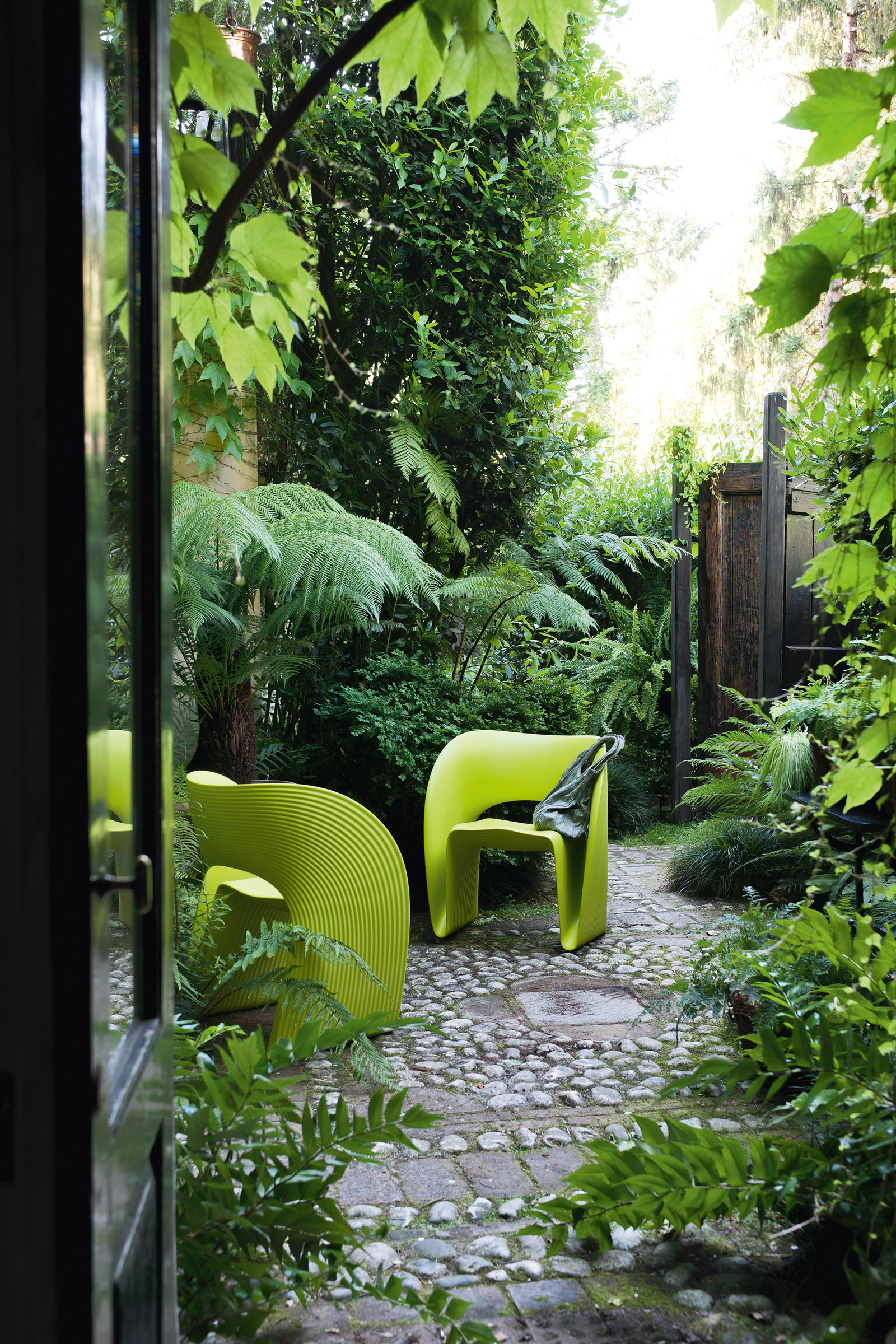
Grass can be stubborn and sometimes there’s no convincing it to thrive. If this is the case, go with it and try a less stressful option. Smart permeable paving ideas with raised planters; gravel and boulder gardens planted with grasses and cacti or, perhaps, a timber deck with potted olive and citrus trees can all create a smart and relaxing outside spot needing very little maintenance.
Faced with a shady area then why not devise a network of meandering garden path ideas weaving through shrubs, bamboo and mounds of ground cover. Cover the ground with bark chippings and cut logs to help suppress weed growth and retain moisture too.

Jill puts her love of plants and all things garden related down to the hours spent pottering around with her Nan and Grandad when she was little. Today she is lucky enough to have a garden of her own in Surrey, England, and spends much of her time writing about them too.
